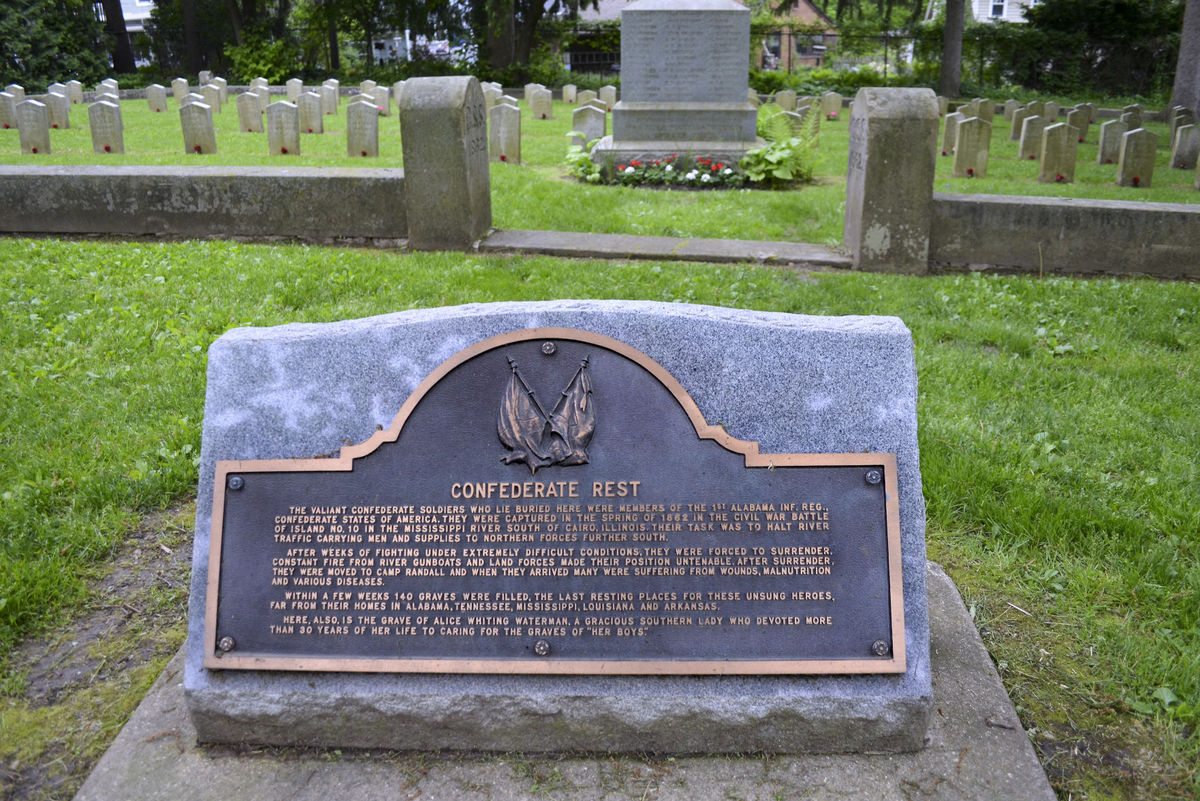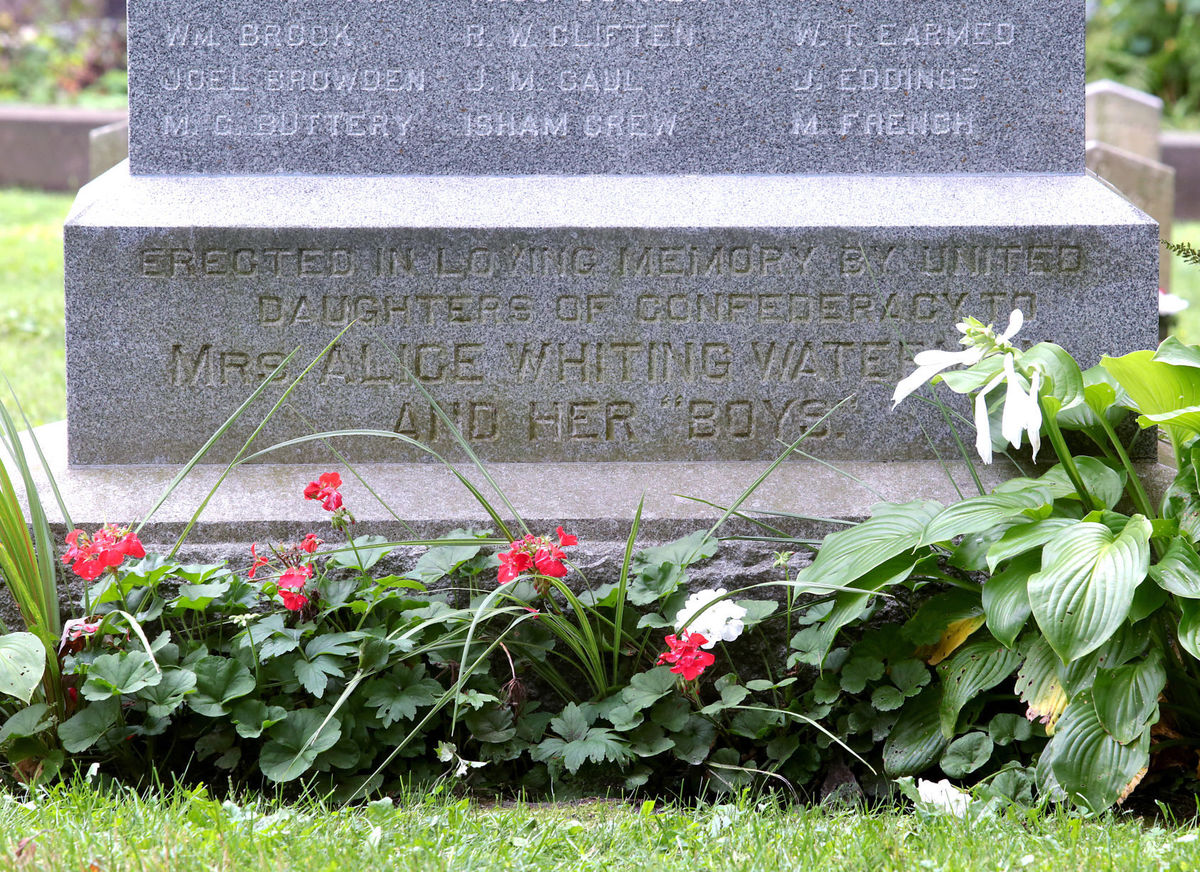
| A Timeline of Civil War Memorials | ||
|---|---|---|
| United States | Madison | |
| 1857 | ||
| In Dred Scott v. Sanford the Supreme Court rules that a slave, or a descendant of slaves, is not an American citizen and has no standing to sue in federal court for freedom in a free state.6 | The City of Madison purchases land for Forest Hill Cemetery to replace the village cemetery in Block 180, now Orton Park.3 | |
| 1862 | ||
| Confederate forces surrender to end the Battle of Island No.10 on the Mississippi River, and 4,500 to 6,700 Confederate soldiers are captured.4 The soldiers on both sides are typically “white, native-born, farmer, protestant, single, and between 18 and 29.” Reasons to volunteer on both sides are patriotism, state pride, adventure, and steady pay. Union soldiers want to preserve the Union, and Confederates to defend their homes. Later, increasing numbers of Federals fight to abolish slavery, while some Confederates fear equal rights for African Americans.14 | Madison Mayor George B. Smith writes in his diary that Lincoln should “be impeached and legally and constitutionally deposed from the high office of President.” 10 881 Confederate prisoners of war are the first to arrive at Camp Randall, Madison from Island No.10.11 Eventually the Camp holds 1200 to 1400 Confederate soldiers.12 138 to 140 are buried in Section 22 of Forest Hill Cemetery.2,3Alice Whiting Waterman, born in Baton Rouge, Louisiana, moves to Madison in 1868 and cares for the Confederate graves until her death in 1897.2 | |
| 1894 | ||
| The United Daughters of the Confederacy is established with the goals of creating a social network, memorializing the war, maintaining a “truthful record of the noble and chivalric achievements” of Confederate veterans, and teaching the next generation “a proper respect for and pride in the glorious war history.” The organization’s treatment of the Civil War as an honorable struggle for the Southern way of life while minimizing the role of slavery has been viewed by some as racist.5 | A final report by the University of Wisconsin exonerates Professor Richard T. Ely of charges of socialism by Superintendent of Public Instruction Oliver Elwin Wells. It states “Whatever may be the limitations which trammel inquiry elsewhere we believe the great state University of Wisconsin should ever encourage that continual and fearless sifting and winnowing by which alone the truth can be found.” 7 | |
| 1906 | ||
| An earthquake and fires kill at least 3,000 in San Francisco. The Confederated Southern Memorial Association publishes a history that includes a picture of Alice Whiting Waterman and is “Dedicated to the Confederate Soldier and All who loved, lost or suffered, in that Cause, The grandest that ever rose, The purest that ever fell.” 13 An Atlanta race riot kills up to 100 African Americans, some hanged from lampposts, after newspaper stories of rapes. The mayor says, “As long as the black brutes assault our white women, just so long will they be unceremoniously dealt with.” 8 | Union Major Frank Oakley, with the support of former Governors and Union Generals Lucius Fairchild and Caldwallader Washburn, requests a donation from the United Daughters of the Confederacy for a memorial in Forest Hill Cemetery to the Confederate soldiers and Alice Whiting Waterman. Their purpose is to unify the Country after the division of the Civil War.15 The United Daughters of the Confederacy erects a monument with the names of the soldiers and Mrs. Waterman. The organization also provides 140 “Crosses of Honor” to mark the soldiers’ graves.2 | |
| 1930 | ||
| The Great Depression and Prohibition continue. Cartoon character Betty Boop premieres and 3M introduces Scotch Tape. Clarence Birdseye begins to sell frozen foods in Springfield, Massachusetts. Hostess Twinkies are invented in Schiller Park, Illinois by James Alexander Dewar, a baker for the Continental Baking Company. J. Thomas Shipp and Abraham S. Smith are lynched in Marion, Indiana after being arrested as suspects in a robbery, murder and rape case. No one is ever charged for their murders. This is the last recorded lynching of African Americans in the northern United States. A widely circulated photo of the hangings is the inspiration for the poem “Bitter Fruit” and the Billie Holiday song “Strange Fruit”, both by Abel Meeropol.16 | For many years Wisconsin governors decorate the Confederate graves on Memorial Day, a tradition the Confederate Veterans’ Association calls a “beautiful and touching tribute.” 2 Madison dignitaries, including Mayor Albert G. Schmedeman and Governor Walter J. Kohler, host the United Daughters of the Confederacy at Forest Hill Cemetery for 1930 Memorial Day ceremonies. American flags are placed at both Union and Confederate graves. “Madison did not view the war’s legacy in racial terms or acknowledge the deep seeded segregation that existed in Wisconsin and the nation. There was an entirely different interpretation of the war then, which, yes, was perpetuated by groups like the [United Daughters of the Confederacy].” 15 | |
| 1981 | ||
| The first NASA space shuttle Columbia is launched and orbits the Earth 37 times at a rate of 1-1/2 hours per orbit. The Centers for Disease Control report the first cases of AIDS. The murder of Michael Donald by Ku Klux Klan members in Mobile, Alabama is the last recorded lynching of an African American in the United States. Henry Hays is sentenced to death and executed in 1997. James Knowles is sentenced to life in prison after pleading guilty and testifying against Hays.9 | The “Confederate Rest” marker, privately funded by William and Evelyn Huggins, is placed in Forest Hill Cemetery to mark the graves of the “valiant Confederate soldiers” and “unsung heroes.” 1 Although he has never lived in the South, Huggins is a member of the Sons of Confederate Veterans.15 A wreath is sent by a former Commander-in-Chief of that organization, and Confederate flags for each grave are provided by the United Daughters of the Confederacy.2 | |
| 2017 | ||
| A violent protest on August 12 involving neo-Nazis and white supremacists in Charlottesville, Virginia leaves one person dead and several others injured. Afterwards steps are taken throughout the United States to remove statues and monuments dedicated to the Confederacy. President Donald Trump tweets: “Sad to see the history and culture of our great country being ripped apart with the removal of our beautiful statues and monuments.” 1 | On August 16 Mayor Paul Soglin directs city staff to remove the 1981 Confederate Rest marker and the larger 1906 monument, saying “There should be no place in our country for bigotry, hatred or violence against those who seek to unite our communities and our country. We are acknowledging there is a difference between remembrance of history and reverence of it.” 1Confederate flags have not been permitted by Forest Hill Cemetery rules since May.17 | |
A joint Common Council committee meeting will be held on January 30 to consider the future disposition of the memorials.

1 “Madison Mayor Paul Soglin orders removal of Confederate monuments at Forest Hill Cemetery,” Logan Wroge, Wisconsin State Journal, Aug 18, 2017
2 “Dying like Rotten Sheepe”: Camp Randall as a Prisoner of War Facility during the Civil War. The Wisconsin Magazine of History, 92(1), 2-15. Thompson, T. (2008). Retrieved from http://www.jstor.org/stable/25482093
3 “Orton Park,” City of Madison Parks Division, retrieved 01/11/18
4 “Battle of Island Number Ten,” Wikipedia, retrieved 01/10/18
5 “United Daughters of the Confederacy,” Wikipedia, retrieved 01/10/18
6 “Dred Scott v. Sandford,” Wikipedia, retrieved 01/10/18
7 “Sifting and winnowing,” Wikipedia, retrieved 01/11/18
8 “1906 in the United States,” Wikipedia, retrieved 01/11/18
9 “Murder of Michael Donald,” Wikipedia, retrieved 01/10/18
10 “Madison’s uncivil Civil War”, Stu Levitan, Isthmus, June 30, 2011
11 “Arrival of Secession Prisoners,” Wisconsin Daily State Journal, April 21, 1862
12 “Confederate Prisoners at Camp Randall as Seen in Newspaper Articles,” Wisconsin Historical Society, retrieved 01/10/18
13 “History of the confederated memorial associations of the South,” Confederated Southern Memorial Association (U.S.), The Graham Press, New Orleans, 1904
14 “Civil War Soldiers,” HistoryNet, retrieved 01/11/18
15 “Wisconsin Embraced Confederate History Throughout the 20th Century,” Chris Lese, Historicalese, October 15, 2017
16 “1930 in the United States,” Wikipedia, retrieved 01/11/18
17 Forest Hill Cemetery Rules & Regulations, Board of Park Commissioners, City of Madison, May 10, 2017
Reply
You must be logged in to post a comment.